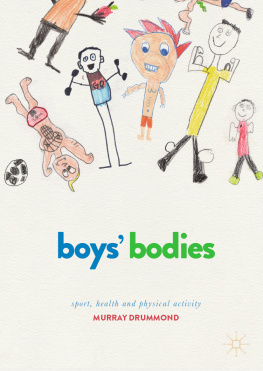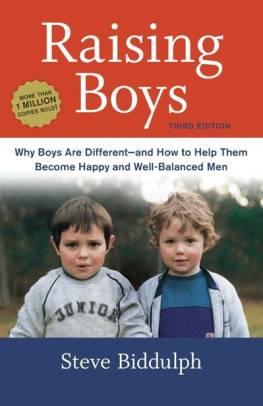

Copyright 2008 by Michael Thompson, Ph.D., and Teresa H. Barker
All rights reserved.
Published in the United States by Ballantine Books, an imprint of The Random House Publishing Group, a division of Random House, Inc., New York.
BALLANTINE and colophon are registered trademarks of Random House, Inc.
Photo Credits: Chapter 1: Lauren Giordano; Chapter 2: Kristin Lake, Look Out Art; Chapter 3: Kristin Lake, Look Out Art; Chapter 4: Joel Preston Smith, www.joelprestonsmith.com; Chapter 5: 2005 Jeff McCall; Chapter 6: J. D. Sloan; Chapter 7: 2005 Kelley King; Chapter 8: Joel Preston Smith, www.joelprestonsmith.com; Chapter 9: J. D. Sloan
Library of Congress Cataloging-in-Publication Data
Thompson, Michael.
Its a boy! : understanding your sons development from birth to age 18 / Michael Thompson and Teresa H. Barker.
p. cm.
Includes bibliographical references.
1. Boys. 2. Child development. 3. Child rearing. I. Barker, Teresa H. II. Title.
HQ775.T55 2007
305.231081dc22 2007014205
www.ballantinebooks.com
eISBN: 978-0-345-51280-2
v3.0_r1
CONTENTS
CHAPTER ONE: IMAGINING A BOY
What Were You Thinking?
CHAPTER TWO: AN ESSENTIAL LOVE AFFAIR
Your Baby Boy: Birth to Eighteen Months
CHAPTER THREE: BOYS IN MOTION
The Excitement of Being a Toddler: Eighteen Months to Three Years
CHAPTER FOUR: WILD THING: POWERFUL LITTLE BOYS
The Three-and Four-Year-Old Boy
CHAPTER FIVE: READY OR NOT, HERE COMES SCHOOL
Your Son, Five to Seven
CHAPTER SIX: BOYS ON A MISSION
Your Son from Eight to Ten
CHAPTER SEVEN: STARTLING CHANGES
A Time of Extraordinary Physical Change: Ages Eleven to Thirteen
CHAPTER EIGHT: MYSTERY BOY
What Is He Thinking? Ages Fourteen and Fifteen
CHAPTER NINE: ON HIS OWN
Ages Sixteen to Eighteen
AUTHORS NOTE
WE ARE GRATEFUL TO THE HUNDREDS OF INDIVIDUALS WHO, THROUGH personal interviews, letters, books, research, and online surveys, have shared their stories, their expertise, and their insight in these pages. With the exception of professionals and a few other individuals who gave permission to use their names, all names and some personal characteristics of patients, parents, children, and others have been changed to protect their privacy. In some instances, some additional details have been changed for the same purpose. Any resulting resemblance to persons living or dead is entirely coincidental and unintentional. This book is designed to provide authoritative information in regard to the subject matter; however, neither the publisher nor the authors intend it as a substitute for professional care for any individual. For all matters of an individual nature, please seek appropriate professional attention.
INTRODUCTION
Boys Really Are Different
I HAVE BEEN TALKING TO PARENTS AND TEACHERS ABOUT BOYS FOR MY ENTIRE professional life, first as a middle school teacher, then as a high school counselor, and for the last twenty-five years as a psychologist. I have listened to parents in my office, consulted with teachers in school settings, and more recently answered the anxious e-mails of parents online. When I had a private office, 70 percent of my clients were boys and men. Now that I no longer have a clinical practice, I still work with boys every week, both at the boys school in Massachusetts where I have been the consulting psychologist for fourteen years and also at the thirty or so schools I visit between September and June. Boys always inspire me. I see their great energy, compassion, and insight. I am witness to boys devotion to their families, to God, to their loving relationships with their brothers and sisters, to their passionate pursuit of music, acting, and athletics. I watch them grapple with the challenges of school and problems in living and succeed. I love boy energy, enthusiasm, and humor. I also see that things are not easy for boys, and they are never simple.
Until very recently, we used to thinkor want to thinkthat boys and girls were the same; or at least we werent allowed to say, if we wanted to be politically correct, that boys and girls were different. Obviously, weve always known that we were raising children who had different bodies, genitals, and hormone systems; however, we assumed that boys and girls had more or less the same brains and that they needed mostly the same things from their parents to grow to become healthy adults. That is why in the past, the finest baby and parenting guides, such as those by pediatricians T. Berry Brazelton, Penelope Leach, and Benjamin Spock, hardly mentioned gender differences at all. They did not give different instructions for raising girls and boys.
Today, we are looking at our sons through two new lenses. One lens, the increase in our scientific knowledge about boys, is potentially enormously helpful to them and us. The other lens, our anxiety about and fear of boys, is quite destructive to them. Parents do their best to maintain a balanced perspective, but it can be challenging at times.
Moms, especially, wonder about their sons: Is this normal? Should I be worried? Boys tend to be much more physical and to take more risks than girls; they tend to get into trouble in school more, or take it less seriously than girls seem to. Much of this can be normal developmentally; sometimes, however, it can be cause for concern. My hope is that by understanding your sons development, you will be alert for those times when your concerns are justified, and know when you can sit back and enjoy your sons healthy boy-ness.
Lets take a moment to consider the new discoveries about boys. Recent research, in part the result of our ability to look inside the brain when it is operating, has demonstrated that the brains of girls and boys are more different than we have understood in the past. Steven Pinker, a professor of psychology at Harvard University, declares that there are sixty significant differences between males and females that have been discovered to date; some seem highly relevant to how we teach and raise boys.
When researchers give boys and girls the same language rhyming task and discover that different parts of their brains light up on a PET scan, we have to sit up and take notice, because it may explain so much about the differential performance of boys and girls in elementary school, and it may guide how we teach reading to boys in the future.
When neuroscientists can peer into the brains of boys with attention deficit hyperactivity disorder and see that their brains function differently than those of the majority of boys and girls, we have insight into the fidgety, distractible behavior of some boys.
When we understand that boys and girls differ in the ratio of gray matter and white matter that they possess in their brains, that boys brains develop more slowly than girls in some ways, and that boys may hear and see somewhat differently than girls, we may be unlocking the biological explanation for commonsense observations about boys that people have made for hundreds of years: they are immature in comparison to girls, grow up at a slower pace, and learn to read more slowly.
Researchers working with infants have shown that boys may be more vulnerable to disruptions in their early attachments to their mothers and fathers, and that their need for maternal and paternal attunement is just as great, if not greater, than that of girls.
Next page







